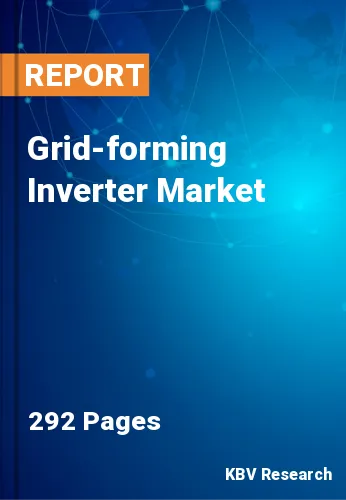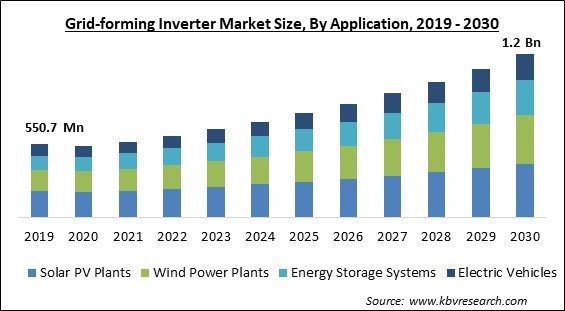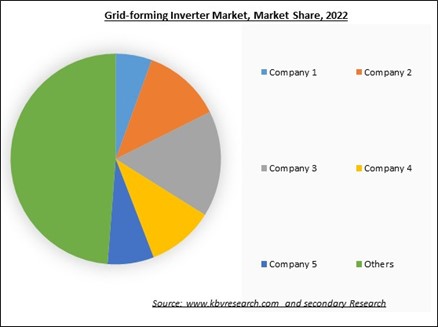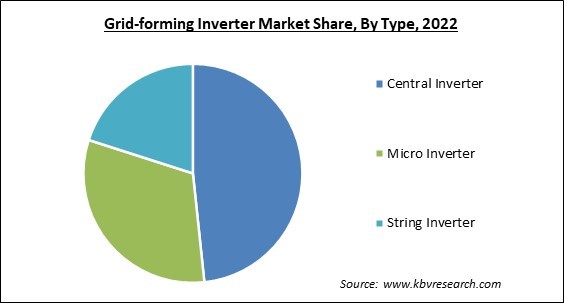
The Global Grid-Forming Inverter Market size is expected to reach $1.2 billion by 2030, rising at a market growth of 9.2% CAGR during the forecast period.
In North America, there is growing interest in microgrids, notably for vital infrastructure, military sites, and remote communities. Hence, the North America region captured $171.7 million revenue in the market in 2022. Microgrid solutions integrating grid-forming inverters are becoming more popular due to the growing emphasis on grid resilience and natural disaster preparedness. Grid-forming inverters are essential for microgrids because they enable them to function independently or in conjunction with the main grid. Some of the factors impacting the market are rising renewable energy investment, effective outage, grid reliability, and inherent operational efficiency, and higher costs than grid-following inverters.

The market is driven primarily by rising investments in the renewable power sector. Investments in renewable power generating technologies, including solar, wind, and hydropower, have significantly increased as the world transitions toward a more sustainable energy future. In conclusion, the need for grid-forming inverters will grow because of the expanding use of renewable energy sector, which will drive the growth of the market. Additionally, the grid is an advanced electricity supply network that uses digital communications technology to identify in real-time, react to local changes in usage, and enable automatic network self-healing in the event of a power outage. It is a sophisticated addition to the current electrical grid network that offers advanced feedback options, including, among others, active network management (ANM) systems and demand response management systems (DRMS). As a result of the rising effective outage, grid reliability, and inherent operational efficiency, the market is expected to grow in the coming years.
However, Grid-forming inverters are more complicated than grid-following inverters because they must actively regulate the voltage and frequency of the grid. This requires more sophisticated hardware and control algorithms. On the other hand, grid-following inverters just need to be able to watch the grid's voltage and frequency, which may be accomplished with less sophisticated hardware and control algorithms. Therefore, due to the extra complexity, grid-forming inverters are often costlier than grid-following inverters. Therefore, these obstacles may impede the market's growth in the coming years.
Based on application, the market is classified into solar PV plants, wind power plants, energy storage systems, and electric vehicles. The wind power plants segment acquired a substantial revenue share in the market in 2022. Wind power plants increasingly use grid-forming inverters to promote grid stability and improve the integration of wind energy into the electrical grid. These specialized inverters play a vital role in establishing and sustaining a stable grid environment, allowing wind power plants to operate in grid-forming mode instead of relying solely on the stability of the existing grid.

The leading players in the market are competing with diverse innovative offerings to remain competitive in the market. The above illustration shows the percentage of revenue shared by some of the leading companies in the market. The leading players of the market are adopting various strategies to cater to demand coming from the different industries. The key developmental strategies in the market are Acquisitions, and Partnerships & Collaborations.
By type, the market is categorized into micro inverter, string inverter, and central inverter. In 2022, the string inverter segment covered a considerable revenue share in the market. String inverters are typically more cost-effective for smaller-scale solar PV installations. They provide a good balance of performance and cost, making them an attractive option for residential and small commercial projects. When compared to other types of grid-forming inverters, which are more sophisticated, string grid-forming inverters are often easier to install and maintain.

On the basis of voltage, the market is divided into 100-300 V, 300-500 V, and above 500 V. The 300 - 500 V segment garnered a significant revenue share in the market. Grid-forming inverters with input voltage levels between 300 to 500 V are versatile components used in a wide range of applications, including residential solar installations, commercial projects, microgrids, energy storage systems, and off-grid solutions. Grid-forming inverters operating with input voltage levels between 300 to 500 volts (V) are commonly used in various renewable energy and microgrid applications. These inverters play a critical role in converting the DC power generated by sources such as solar panels and batteries into AC power that can be synchronized with the grid or operate in islanded mode.
By power rating, the market is segmented into below 50 KW, 50–100 KW, and above 100 KW. The below 50 KW segment registered the maximum revenue share in the market in 2022. Grid-forming inverters with capacities below 50 kW serve as building blocks for smaller-scale energy systems. They enable energy generation, distribution, and control in a variety of contexts, ranging from residential solar installations to microgrids in remote communities and beyond. These inverters contribute to the decentralization and democratization of energy production, enhancing energy efficiency and sustainability.
| Report Attribute | Details |
|---|---|
| Market size value in 2022 | USD 618.2 Million |
| Market size forecast in 2030 | USD 1.2 Billion |
| Base Year | 2022 |
| Historical Period | 2019 to 2021 |
| Forecast Period | 2023 to 2030 |
| Revenue Growth Rate | CAGR of 9.2% from 2023 to 2030 |
| Number of Pages | 292 |
| Number of Table | 450 |
| Report coverage | Market Trends, Revenue Estimation and Forecast, Segmentation Analysis, Regional and Country Breakdown, Market Share Analysis, Companies Strategic Developments, Company Profiling |
| Segments covered | Type, Application, Voltage, Power Rating, Region |
| Country scope | US, Canada, Mexico, Germany, UK, France, Russia, Spain, Italy, China, Japan, India, South Korea, Singapore, Malaysia, Brazil, Argentina, UAE, Saudi Arabia, South Africa, Nigeria |
| Growth Drivers |
|
| Restraints |
|
Free Valuable Insights: Global Grid-forming Inverter Market size to reach USD 1.2 Billion by 2030
Region wise, the market is analyzed across North America, Europe, Asia Pacific, and LAMEA. In 2022, the Asia Pacific region led the market by generating the highest revenue share. In the Asia Pacific region, the adoption of energy storage technologies, such as battery storage, is increasing momentum. Energy storage facilitates system stability and improves renewable energy integration by storing excess renewable energy and releasing it when demand is high. Governments are revising and implementing new policies and regulations that promote renewable energy grid integration.
The market research report covers the analysis of key stakeholders of the market. Key companies profiled in the report include Huawei Technologies Co., Ltd. (Huawei Investment & Holding Co., Ltd.), SolarEdge Technologies, Inc., Enphase Energy, Inc., Schneider Electric SE, General Electric Company, Delta Electronics, Inc., Sungrow Power Supply Co., Ltd., Fimer Group, KACO new energy GmbH and GoodWe.
By Application
By Type
By Voltage
By Power Rating
By Geography
The Market size is projected to reach USD 1.2 billion by 2030.
Rising renewable energy investment are rising are driving the Market in coming years, however, Higher costs than grid-following inverters restraints the growth of the Market.
Huawei Technologies Co., Ltd. (Huawei Investment & Holding Co., Ltd.), SolarEdge Technologies, Inc., Enphase Energy, Inc., Schneider Electric SE, General Electric Company, Delta Electronics, Inc., Sungrow Power Supply Co., Ltd., Fimer Group, KACO new energy GmbH and GoodWe.
The Solar PV Plants segment is generating the highest revenue in the Market by Application in 2022; thereby, achieving a market value of $405.5 million by 2030.
The Above 500 V segment is leading the Market by Voltage in 2022, thereby achieving a market value of $467.2 million by 2030.
The Asia Pacific region dominated the Market by Region in 2022, and would continue to be a dominant market till 2030; thereby, achieving a market value of $487.8 million by 2030.
Our team of dedicated experts can provide you with attractive expansion opportunities for your business.
